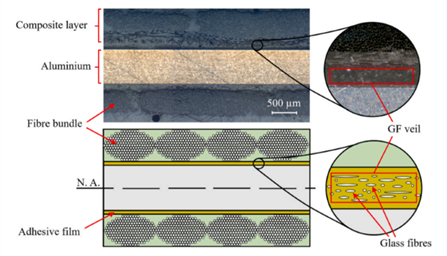A recent study conducted by the University of Edinburgh on vacuum-infused thermoplastic fibre-metal laminates has highlighted the performance benefits of TFP’s 6 gsm glass nonwovens as adhesive carriers within Fibre Metal Laminates (FMLs).
Fibre Metal Laminates combine layers of composite and metal, creating a unique set of material properties that are an effective balance of the advantages and disadvantages of their constituents.
Initially developed for the aerospace industry, FMLs have many advantages; they are lightweight, have a high damage tolerance, and demonstrate good fatigue, corrosion and impact properties. The versatility and mechanical properties of FML technology show promise for expansion into other sectors as well, such as wind energy and marine transport, especially when combined with new reactive thermoplastic systems.
Combining these technologies presents challenges, particularly the optimisation of the metal-composite interface for good adhesion. The constituent materials are dissimilar, potentially causing weak interfacial bonding leading to delamination and loss of integrity.
The study, titled ‘Vacuum-infused thermoplastic fibre-metal laminates – Advances in bonding and recycling’, evaluates the utilisation of nonwovens as a carrier for the adhesive to improve the bond line uniformity and interfacial bonding, the latter of which is characterised by a high Interlaminar Shear Strength (ILSS). TFP’s lightweight nonwovens are already used extensively in the aerospace industry as a carrier or support for adhesive films in more traditional composite layups. They facilitate uniform wet out of adhesive, setting the bond line to ensure a defined and consistent film thickness, whilst ultimately improving the resilience and handling of the final product.
This study investigated the strength of the bonding within fibre-metal laminates (FMLs), evaluating the impact of using 3 different glass fibre carrier veils with areal weights of 6, 17, and 34 g/m2. The FMLs were manufactured using a standard vacuum infusion process (VIP), with an adhesive carrier (fabricated using TFP’s glass veil and methacrylate adhesive) incorporated between the layers of composite and aluminium - the stacking sequence of each FML was [0/Al/0], as shown in Fig. 1 below.


Figure taken from Maguire J.M. et al (2023) ‘Vacuum-infused thermoplastic fibre-metal laminates – Advances in bonding and recycling’ Materials Today Communications, 37, pp 1-5.
The laminates were subjected to Short Beam Shear (SBS) testing to evaluate the ILSS and determine which carrier delivered the most effective bonding. The results indicated that TFP’s 6g/m2 lightweight fine glass veil performed best; the thin, highly porous veil architecture enabled rapid and consistent impregnation with the adhesive to create a thin, uniform bond line.
The study demonstrates the importance of the use of TFP materials in this area, enabling the use of FMLs in new sectors and applications. Key takeaways from the study include:
- Ensuring a consistent and uniform bond line is important for the successful transition of FML technology to an industrial scale. The integration of TFP’s lightweight fine glass as an adhesive carrier enables the necessary control over bond line thickness and maintains uniformity.
- A thin glass fibre veil can be utilised as an adhesive carrier to improve bond line uniformity without reducing the interlaminar shear strength which would indicate a disruption in interfacial bonding. Measurement of the Interlaminar Shear Strength (ILSS), a critical composite property, indicates superior results with TFP’s 6gsm fine glass veil.
To view the full study visit: https://www.sciencedirect.com/science/article/pii/S2352492823016525
Maguire J.M. et al (2023) ‘Vacuum-infused thermoplastic fibre-metal laminates – Advances in bonding and recycling’ Materials Today Communications, 37, pp 1-5.
KEY BENEFITS
- The lightweight veil improves the resilience and ease of handling of the film or fragile material with the minimum possible weight addition.
- The exceptionally uniform fibre distribution enables an even wet out of the adhesive during production.
- The veil sets the bond line by defining the thickness. The uniform veil thickness helps control the level of adhesive to ensure a consistent bond line.
APPLICATIONS
- Fibre Metal Laminates
- Thermoplastics
MARKETS
- Aerospace
- Wind Energy
- Marine Transport

